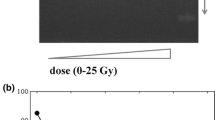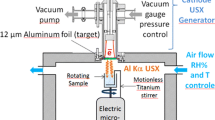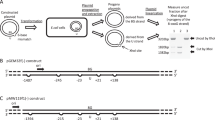Abstract
We have gamma-irradiated plasmid DNA in aqueous solution in the presence of submillimolar concentrations of the ligand tetra-arginine. Depending upon the ionic strength, under these conditions, the plasmid can adopt a highly compacted and aggregated form which attenuates by some two orders of magnitude the yield of damage produced by the indirect effect. The yields of DNA single- and double-strand breaks (SSB and DSB) which result are closely comparable with those produced in living cells. The radical lifetimes, diffusion distances, and track structure are expected to be similarly well reproduced. After irradiation, the aggregation was reversed by adjusting the ionic conditions. The approximate spatial distribution of the resulting DNA damage was then assayed by comparing the increases in the SSB and DSB yields produced by a subsequent incubation with limiting concentrations of the eukaryotic base excision repair enzymes formamidopyrimidine-DNA N-glycosylase (the FPG protein) and endonuclease III. Smaller increases in DSB yields were observed in the plasmid target that was irradiated in the condensed form. By modeling the spatial distribution of DNA damage, this result can be interpreted in terms of a greater extent of damage clustering.







Similar content being viewed by others
References
Bloomfield VA (1996) DNA condensation. Curr Opin Struct Biol 6:334–341
Cadet J, Bourdat A-G, D’Ham C, Duarte V, Gasparutto D, Romieu A, Ravanat J-L (2000) Oxidative base damage to DNA: specificity of base excision repair enzymes. Mutat Res 462:121–128
Chaudhry MA, Weinfeld M (1995) The action of Escherichia coli endonuclease III on multiply damaged sites in DNA. J Mol Biol 249:914–922
Chiu S, Oleinick NL (1998) Radioprotection of cellular chromatin by the polyamines spermine and putrescine: preferential action against formation of DNA-protein crosslinks. Radiat Res 149:543–549
Daban J-R (2003) High concentration of DNA in condensed chromatin. Biochem Cell Biol 81:91–99
Goodhead DT (1994) Initial events in the cellular effects of ionizing radiations: clustered damage in DNA. Int J Radiat Biol 65:7–17
Harrison L, Hatahet Z, Purmal AA, Wallace SS (1998) Multiply damaged sites in DNA: interactions with Escherichia coli endonucleases III and VIII. Nucleic Acids Res 26:932–941
Krisch RE, Flick MB, Trumbore CN (1991) Radiation chemical mechanisms of single and double-strand break formation in irradiated SV40 DNA. Radiat Res 126:251–259
Lutze LH, Winegar RA (1990) pHAZE: a shuttle vector system for the detection and analysis of ionizing radiation-induced mutations. Mutat Res 245:305–310
Milligan JR, Aguilera JA, Ward JF (1993) Variation of single-strand break yield with scavenger concentration for plasmid DNA irradiated in aqueous solution. Radiat Res 133:151–157
Milligan JR, Aguilera JA, Nguyen TT, Paglinawan RA, Ward JF (2000) DNA strand-break yields after post-irradiation incubation with base excision repair endonucleases implicate hydroxyl radical pairs in double-strand break formation. Int J Radiat Biol 76:1475–1483
Milligan JR, Aguilera JA, Paglinawan RA, Ward JF, Limoli CL (2001) DNA strand break yields after post-high LET irradiation incubation with endonuclease-III and evidence for hydroxyl radical clustering. Int J Radiat Biol 77:155–164
Milligan JR, Aguilera JA, Ly A, Tran NQ, Hoang O, Ward JF (2003) Repair of oxidative DNA damage by amino acids. Nucleic Acids Res 31:6258–6263
Newton GL, Aguilera JA, Ward JF, Fahey RC (1996) Polyamine-induced compaction and aggregation of DNA: a major factor in radioprotection of chromatin under physiological conditions. Radiat Res 145:776–780
Newton GL, Aguilera JA, Ward JF, Fahey RC (1997) Effect of polyamine-induced compaction and aggregation of DNA on the formation of radiation-induced strand breaks: quantitative models for cellular radiation. Radiat Res 148:272–284
Newton GL, Ly A, Tran NQ, Ward JF, Milligan J (2004) Radioprotection of plasmid DNA by oligolysines. Int J Radiat Biol 80:643–651
Nikjoo H, Goorley T, Fulford J, Takakura K, Ito T (2002) Quantitative analysis of the energetic of DNA damage. Radiat Prot Dosimetr 99:91–98
Padmanabhan S, Zhang W, Capp MW, Anderson CF, Record MT Jr (1997) Binding of cationic (+4) alanine- and glycine-containing oligopeptides to double-stranded DNA: thermodynamic analysis of effects of coulombic interactions and alpha-helix induction. Biochemistry 36:5193–5206
Pogozelski WK, Tullius TD (1998) Oxidative strand scission of nucleic acids: routes initiated by hydrogen abstraction from the sugar moiety. Chem Rev 98:1089–1108
Spinks JWT, Woods RJ (1990) An introduction to radiation chemistry. Wiley, New York
Spotheim-Maurizot M, Ruiz S, Sabattier R, Charlier M (1005) Radioprotection of DNA by polyamines. Int J Radiat Biol 68:571–577
Sutherland BM, Bennett PV, Sidorkina O, Laval J (2000) Clustered damages and total lesions induced in DNA by ionizing radiation: oxidized bases and strand breaks. Biochemistry 39:8026–8031
Sutherland BM, Georgakilas AG, Bennett PV, Laval J, Sutherland JC (2003) Quantifying clustered DNA damage induction and repair by gel electrophoresis, electronic imaging and number average length analysis. Mutat Res 531:93–107
Terato H, Tanaka R, Nakaarai Y, Nohara T, Doi Y, Iwai S, Hirayama R, Furusawa Y, Ide H (2008) Quantitative analysis of isolated and clustered DNA damage induced by gamma rays, carbon ion beams, and iron ion beams. J Radiat Res (Tokyo) 49:133–146
Tsoi M, Do TT, Tang V, Aguilera JA, Perry CC, Milligan JR (2010) Characterization of condensed plasmid DNA models for studying the direct effect of ionizing radiation. Biophys Chem 147:104–110
Vilfan ID, Conwell CC, Sarkar T, Hud NV (2006) Time study of DNA condensate morphology: implications regarding the nucleation, growth, and equilibrium populations of toroids and rods. Biochemistry 45:8174–8183
von Sonntag C (2006) Free radical induced DNA damage and its repair: a chemical perspective. Springer, New York
Ward JF (1994) The complexity of DNA damage-relevance to biological consequences. Int J Radiat Biol 71:347–363
Warters RL, Newton GL, Olive PL, Fahey RC (1999) Radioprotection of human cell nuclear DNA by polyamines: radiosensitivity of chromatin is influenced by tightly bound spermine. Radiat Res 151:354–362
Yokoya A, Cunniffe SM, Watanabe R, Kobayashi K, O’Neill P (2009) Induction of DNA strand breaks, base lesions and clustered damage sites in hydrated plasmid DNA films by ultrasoft X rays around the phosphorus K edge. Radiat Res 172:296–305
Acknowledgments
This study was supported by PHS grant CA46295.
Author information
Authors and Affiliations
Corresponding author
Rights and permissions
About this article
Cite this article
Do, T.T., Tang, V.J., Konigsfeld, K. et al. Damage clusters after gamma irradiation of a nanoparticulate plasmid DNA peptide condensate. Radiat Environ Biophys 51, 43–52 (2012). https://doi.org/10.1007/s00411-011-0388-3
Received:
Accepted:
Published:
Issue Date:
DOI: https://doi.org/10.1007/s00411-011-0388-3




